Important Shortcut Keys
| Toggle Fullscreen: | F11 (most browsers) |
| Undo Move: | Ctrl+Z |
| Deal Again: | F2 |
| Close Dialogue Box: | Esc |
Freecell
Welcome to Freecell Solitaire! This is a free online version of the popular card puzzle game. Have fun!
Overview
Freecell is a card game that is played by one player. Like in most other solitaires, in Freecell, the objective is to sort cards by suit and rank. However, unlike in traditional Solitaire, all cards are facing up from the start of the game, and there is no stock. Also, Freecell deals are almost always solvable. Therefore, it is hard to treat the outcome of the game as a good or bad omen, as is often done in traditional Solitaire.
The game board consists of eight columns in the middle, four free cells in the top-left corner, and four foundation cells in the top-right corner. In order to win the game, you need to move the cards between the columns and arrange them sequentially with alternating colors. You can use the free cells in the top-left corner of the board to temporarily store cards there. Finally, you need to place all of the cards in the foundation cells, starting with Aces, Twos, Threes, etc. Every stack in a foundation field must contain only cards of a single suit.
Rules of Freecell
Moving Cards Between Columns
- You can pick up a card that is on top of the column, or you can pick up a stack of cards, as long as they are sequential (ordered by rank) and have alternating colors (black and red).
- You can place a card (or a stack of cards) on top of another card, as long as the destination card has a rank one higher and is of the opposite color to the card that you are moving (or than the card at the bottom of the stack that you are moving). That is, it is possible to place a black card on a red card, and vice versa. Note that it is impossible to place a King on another card, since there is no card with a rank above King.
- If the column is empty, then you can place any card in it.
- If you are moving a stack of cards, you need to make sure that there are enough free cells to facilitate the move. This is because, in Freecell, cards can only be moved one-by-one. If you are moving a stack, then it is as if you were using free cells to temporarily store cards while disassembling the stack in one column and then assembling it in another column. This is quite tedious, and the game allows you to move the entire stack, rather than moving cards one-by-one. However, the game always calculates the maximum stack size that can be moved, given the current circumstances. The formula for the maximum stack size includes the number of free cells in the top-left and the number of empty columns.
- It is possible to move larger stacks than those allowed by the number of free cells and the number of empty columns. For example, if you find a card in a different column on which you can temporarily store part of your stack, you can then use it to split your stack in two and move the two halves separately.
Using Free Cells
- There are four free cells.
- Each free cell can contain up to a single card.
- Any card can be placed in a free cell.
- The number of available free cells is used to calculate the maximum size of a stack that you can currently move.
Foundations
- There are four foundation fields: one for each suit. Each foundation field can contain only cards of a single suit.
- The first card to be placed in each foundation field is an Ace. The Ace is a foundation card.
- Once an Ace has been placed in the foundation field, you can only place a card there which has a rank that is higher by exactly one. In this way, you are sorting cards by suit and by rank in ascending order.
- Once all of the cards have been placed in foundation fields, the game is won!
Other Information
- Sometimes, cards will automatically go into foundation fields. Only the cards that cannot be helpful for sorting out the columns are automatically sent to foundation fields.
- You can force-send a card to a foundation field by right-clicking on the card.
- You can force-send all suitable cards to foundation fields by right-clicking on the green area at the bottom of the game board.
- A good amount of time to win the game is 3 minutes.
- Freecell does not have a scoring system. For beginner players, the measure of performance can be the number of cards left on the board (i.e., not in the foundations) at the time when they get stuck and give up. For players who tend to solve games more often, the measure of performance for a single game can be their elapsed playing time. The percentage of games won can indicate their overall performance.
How to play Freecell – Solving Example
Here is an example of how to successfully start solving a Freecell Solitaire game.
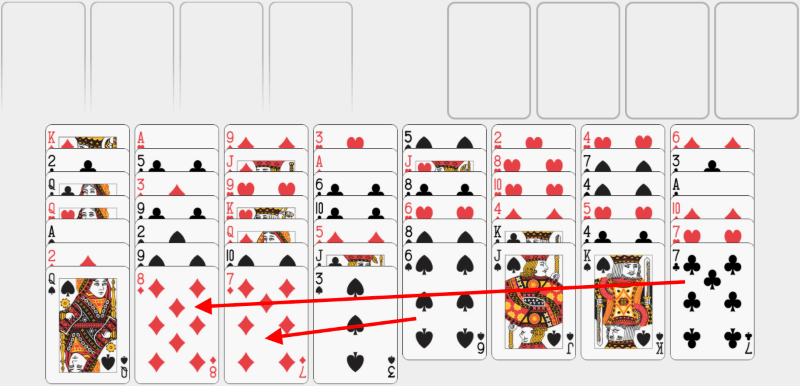 In this deal, there are no Aces on top; however, we can move a bunch of cards around in order to make them available. We start by placing the 7 of Clubs on the 8 of Diamonds, and placing the 6 of Spades on the 7 of Diamonds. Note that we can only place a card on a card that has a rank higher by one, and that it must be of the opposite color. That is, we can only place red cards (Diamonds and Hearts) on black cards (Spades and Clubs), and vice versa. |
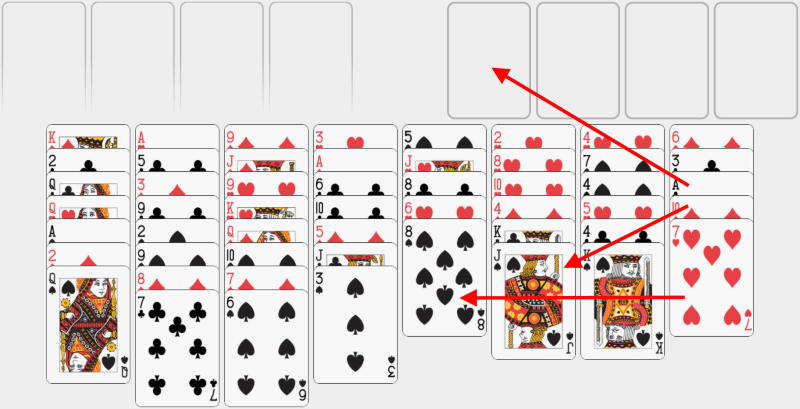 Now, let’s focus on the right-most column. We can move the 7 of Hearts on the 8 of Spades, and the 10 of Diamonds on the Jack of Spades. This reveals the Ace of Clubs, which we can then place in the first foundation cell. |
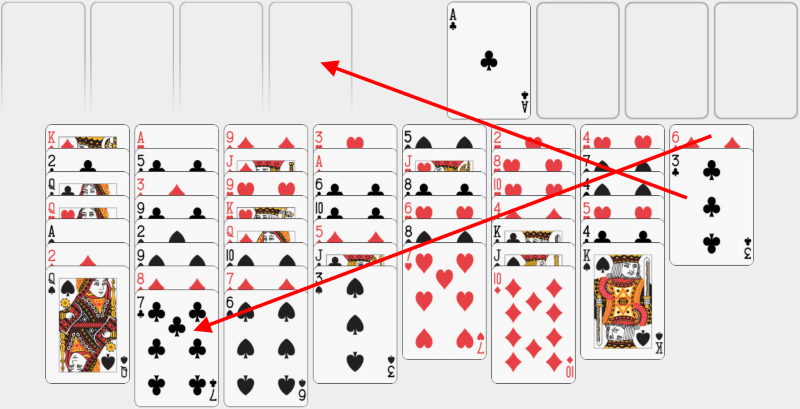 We keep focusing on the right-most column. We can move the 3 of Clubs to one of the free cells and then put the 6 of Diamonds on the 7 of Clubs. This frees up the right-most column. Having an empty column is very desirable, because we can use it not only as an additional free cell, but also to stack cards in it. |
 Now, we can try and disassemble the left-most column. We can do it by placing the Queen of Spades in a free cell, the 2 of Diamonds on the 3 of Spades, the Ace of Clubs in the second foundation field, the Queen of Hearts on the King of Spades, the Queen of Clubs in a free cell, and the 2 of Clubs on the Ace of Clubs (which already is in the foundation cell). This seemingly clutters our board – now we have three out of the four free cells occupied. But fear not! As you will soon see, this was strategically thought through, and we will easily recover the board’s clarity. |
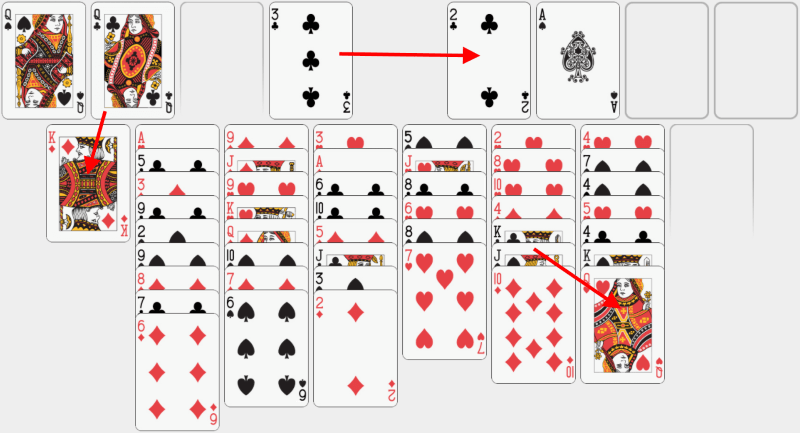 Let’s move the Queen of Clubs onto the King of Diamonds, and the 3 of Clubs onto the 2 of Clubs. We can also move a little stack composed of two cards: the Jack of Spades and the 10 of Diamonds. Let’s pick these cards up and place them on the Queen of Hearts. Now, the board looks quite orderly again! |
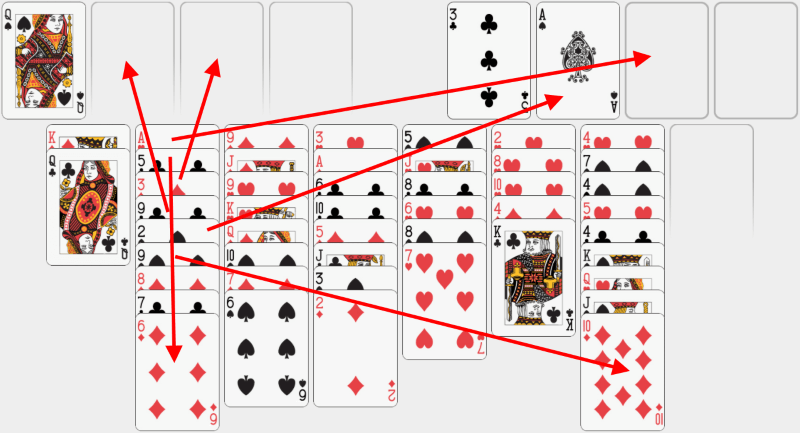 This time, we’ll focus on the second column. Note that there is a stack consisting of four cards, with the 9 of Spades at the bottom. We can move this entire stack and place it on the 10 of Diamonds. The 2 of Spades is then revealed, and we can put it on the Ace of Spades. The 9 of Clubs, along with the 3 of Diamonds, can now be relocated to available free cells. The 5 of Clubs can be placed on the 6 of Diamonds, which is now located in the seventh column. This allows us to achieve our goal: the Ace of Hearts is now revealed, and we can place it in the next available foundation cell. |
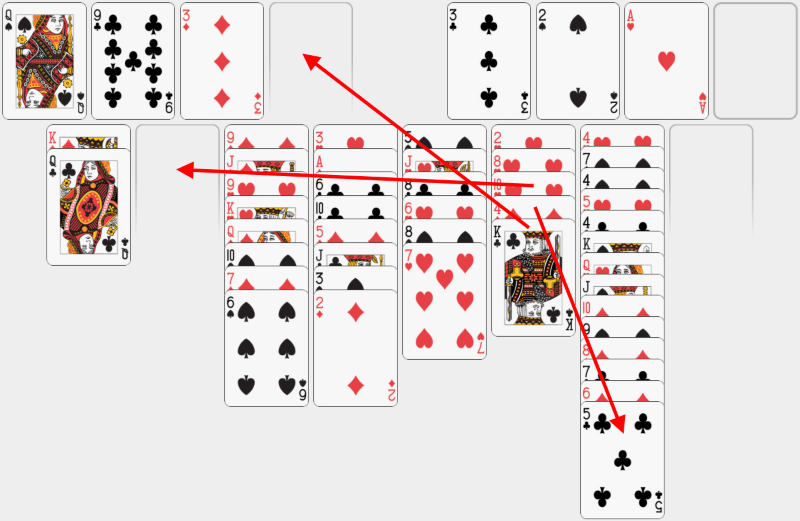 It seems that it would be a good idea to focus on the sixth column next. And so, we move the King of Clubs to the last remaining free cell, the 4 of Diamonds onto the 5 of Clubs, and the 10 of Hearts in the empty second column. |
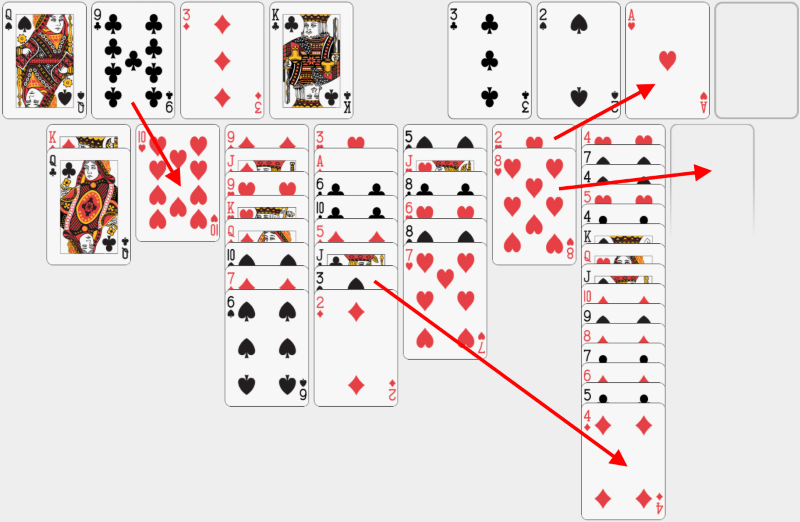 Place the 9 of Clubs on the 10 of Hearts and the 8 of Hearts in the empty eighth column. This reveals the 2 of Hearts, which we can then place in the foundation field with the Ace of Hearts. Finally, place the two-card stack starting with the 3 of Spades on the 4 of Diamonds. |
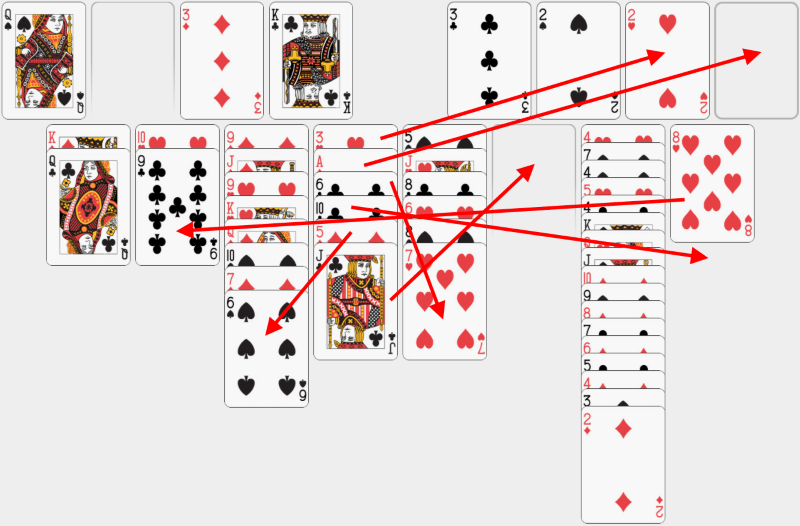 Now, we will try and disassemble the fourth column. First, let’s place the Jack of Clubs in the only empty column remaining. Then, we place the 5 of Diamonds on the 6 of Spades. We need to remove the 8 of Hearts from the eighth column and place it on the 9 of Clubs. Then, we can place the 10 of Clubs in the newly-freed empty column. Now, we can place the 6 of Clubs on the 7 of Hearts, which reveals the Ace of Diamonds. We can place it in the remaining available foundation cell. And finally, we can place the 3 of Hearts on the 2 of Hearts in the foundation cells. Notice that the 2 of Diamonds automatically went to the foundation cell, since there is nothing left on the board that we can place on it. |
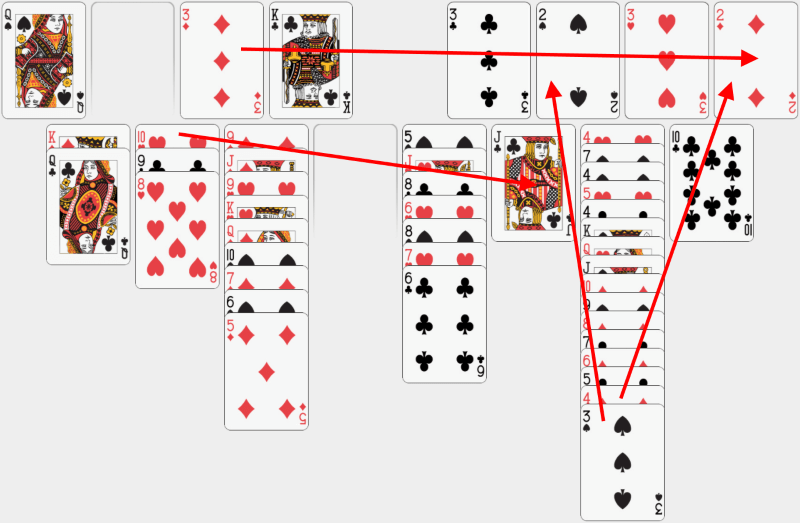 Now, let’s do some clean-up. First, we’ll place the 3 of Diamonds from the free cell onto the 2 of Diamonds in the foundation cell. Then, we can move the stack that starts with the 10 of Hearts and place it on the Jack of Clubs. Finally, we can move the 3 of Spades and the 4 of Diamonds to the suitable foundation fields. |
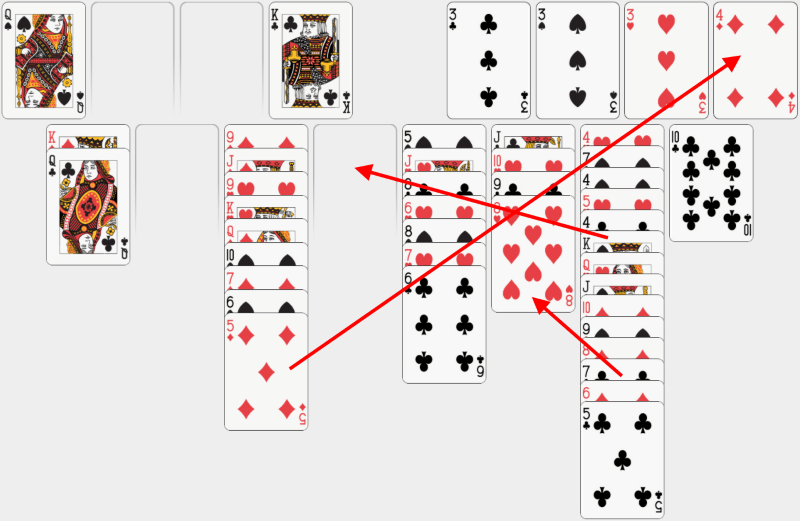 Now, we are going to make a complicated move. But first, let’s move the 5 of Diamonds onto the 4 of Diamonds. With that out of the way, we would like to move the giant stack starting with the King of Spades into an empty column, so that we can then get access to all the cards of the seventh column. Unfortunately, there are not enough free cells and empty columns available to perform this operation. Fortunately, though, we still have a way to do it! We can split the giant stack into two: we can move the three-card-long stack starting with the 7 of Clubs onto the 8 of Hearts, and then move the remaining stack (starting with the King of Spades) into the empty column. |
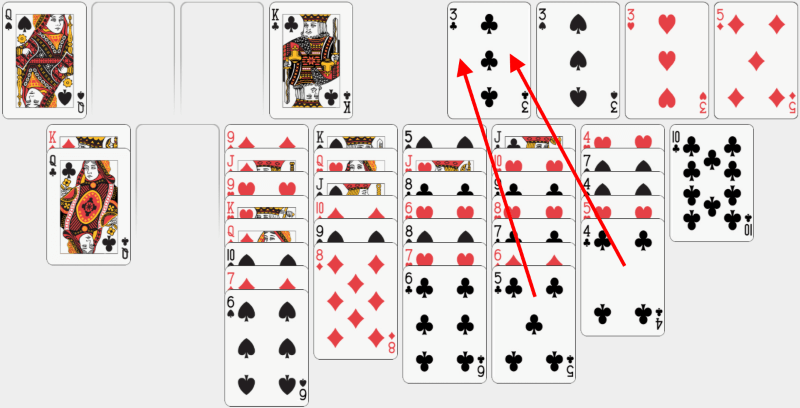 Move the 4 of Clubs into the foundation field. Then, do the same with the 5 of Clubs. |
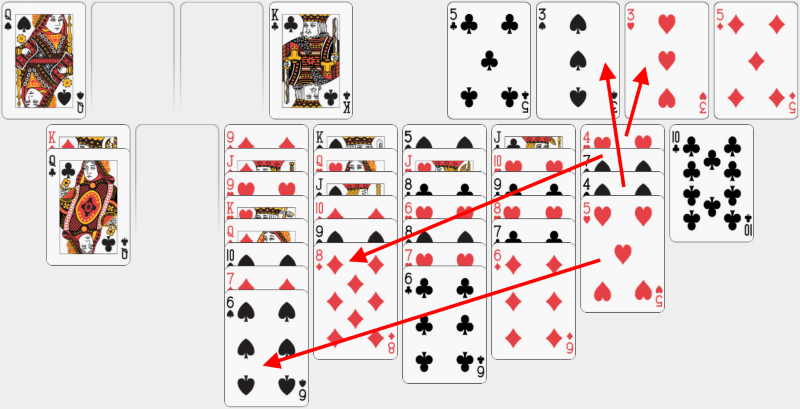 We can finally disassemble the seventh column. Place the 5 of Hearts on the 6 of Spades, the 4 of Spades onto the 3 of Spades, and the 7 of Spades onto the 8 of Diamonds. And finally, place the 4 of Hearts onto the 3 of Hearts. |
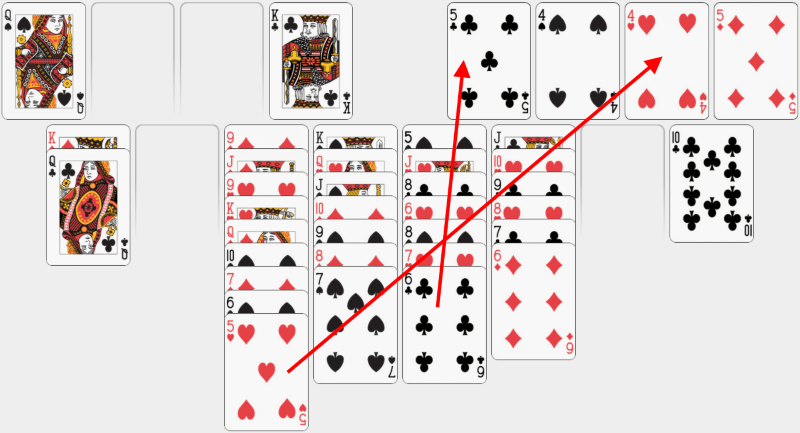 Let’s fill up the foundation fields a bit. Move the 6 of Clubs onto the 5 of Clubs. Then, we’ll move the 5 of Hearts onto the 4 of Hearts. |
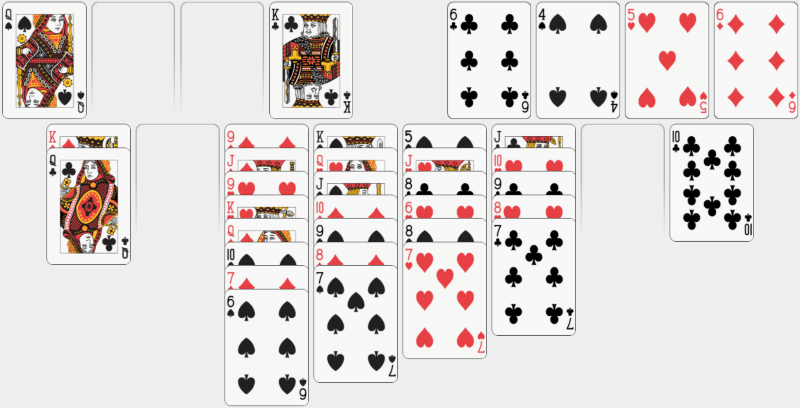 We now have two free cells and two empty columns. The cards are already quite well-sorted on the board, and it is clear that the game can be solved. From now on, it will only get easier and easier. Well done! :) |
History
Freecell Solitaire can trace its origins back to the year 1968, when a slightly different game was published in the Scientific American. This game has been modified into Freecell, and was first implemented on computers in 1978. However, Freecell has mostly been able to become so popular because it has been included in every distribution of Microsoft Windows since 1995. The original Microsoft Freecell had 32,000 numbered deals. Between 1994 and 1995, there was a project to solve all 32,000 deals, and only one proved to be unsolvable. From that point, Freecell became known as a game which is almost always solvable.
Copyright © 2021-2025 simiade.com. All rights reserved. | Terms and Conditions | Privacy Policy